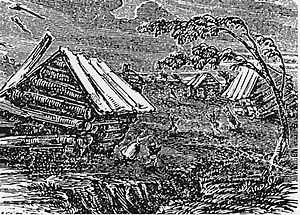Slave George facts for kids
George Lewis (also known as Slave George) was an African American boy. He was born into slavery in 1794. George was killed in western Kentucky on December 15, 1811. The people who killed him were Lilburn and Isham Lewis. They were grown sons of Dr. Charles Lilburn Lewis and Lucy Jefferson Lewis. They were also nephews of Thomas Jefferson. The brothers were related to Meriwether Lewis from the famous Lewis and Clark journey.
This sad event happened at the same time as the big New Madrid earthquake. The Lewis family was well-known, so the story quickly became famous. Lilburn Lewis died soon after being released from jail. Isham escaped and was never seen in the area again. People think he died in the Battle of New Orleans in 1815.
George's Early Life
George was born in Virginia in 1794. He was enslaved by the Lewis family. He grew up working in the house, learning kitchen tasks and other duties. In 1806, Randolph and Lilburn Lewis moved to Kentucky with their families. They took the people they enslaved with them, including George.
What Happened
In 1811, Lilburn and Isham Lewis were sad because their mother and older brother Randolph had died. Lilburn had also lost his first wife that year. He had remarried a woman named Letitia. Lilburn was having money problems and trying to care for his five children.
George was 17 years old and enslaved by Lilburn Lewis. Isham was visiting Lilburn. One night, George accidentally broke a water pitcher. It belonged to their mother. Lilburn and Isham became very angry. They killed George in front of seven other enslaved people.
The New Madrid Earthquake
Lilburn wanted to hide what they had done. He tried to get rid of George's body. But then a huge earthquake struck. It was the most powerful earthquake ever recorded in the eastern U.S. It happened at 3:15 a.m. Eastern time. This was 2:15 a.m. in the Central Standard Time where they were in western Kentucky.
In the days after, the brothers made other enslaved people rebuild the chimney. They hid George's remains inside it. Two more big earthquakes hit the area later. One was on January 23, 1812, and another on February 7, 1812. The second earthquake caused part of the chimney to fall. This showed George's remains.
In early March 1812, neighbors found George's remains. They learned he had been killed. Even though George was enslaved, killing him was against the law. Lilburn and Isham Lewis were quickly investigated and arrested. They were charged with the crime.
After they were released, Lilburn died on April 9, 1812. Isham escaped from jail and disappeared. Many books and articles have looked at George's case since 1812.
See also
 In Spanish: El esclavo George para niños
In Spanish: El esclavo George para niños
- Slavery in the United States
- List of slaves
- War of 1812


